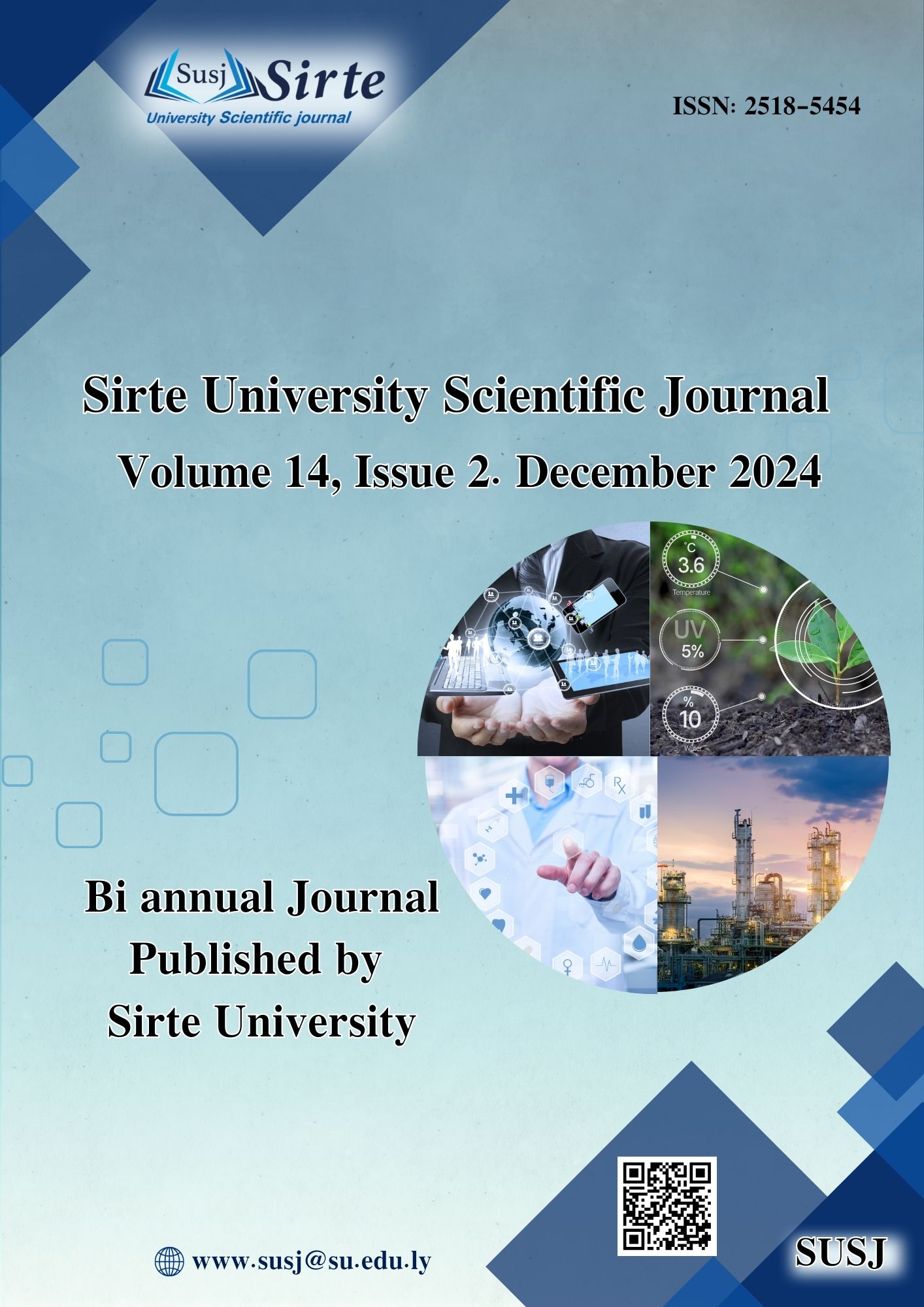Relationship between the students’ spatial visualisation abilities and their performance of deducing 2D-Orthographic drawing
DOI:
https://doi.org/10.37375/susj.v14i2.3098Keywords:
Eng-drawing, L-SA, H-SA, time, accuracy, isometric, orthographic projectionAbstract
Many researches indicated that students’ spatial ability influences their academic performance in engineering drawing and design. Significantly, a major limitation of traditional instruction is the problem of presenting three-dimensional spatial information in a two-dimensional format. Yet, there is no evidence base of how spatial ability influence the Eng-drawing learners’ practice performance. This paper investigated the effects of the spatial ability level on novice Eng-drawing learners’ practice performance in terms of shorting the learning time and increasing the drawing accuracy or not. 32 students from architecture department at the Sirte university were assigned equally into two groups regarding to their SA scores (high vs. low) to undertake specific Eng-drawing learning tasks of deducing the orthographic projection from an isometric model. The time taken and drawing accuracy were recorded. The results indicated that SA significantly related to drawing accuracy, but had little effect on learning time.
References
Lohman, D. F. (1996). Spatial ability and G. In I. Dennis and P. Tapsfield (Eds.), Human abilities: Their nature and measurement (pp. 97-116). Mahwah, NJ: Erlbaum.
Towle, E.J.M., and Kinsey, B. Work In Progress-Development of Tools to Improve the Spatial Ability of Engineering Students. in 35th ASEE/IEEE Frontiers in Education Conference. October 19 - 22, 2005. Indianapolis, IN.
Sorby, S. A., 1999. Developing 3-D spatial visualization skills. The Engineering Design Graphics Journal, 63(2), 21-32.
Hitoshi, S., Sanae, S. and Hajime, Y., 2001. The Use of Internet Technology for the Development of 3-D Spatial Skills. Proceedings of 2nd International Conference on Information Technology Based Higher Education and Training, Kumamoto, Japan. July 4-6, 2001.
Alias, M., Black, T. R., and Gray, D. E., 2003. The relationship between spatial visualisation ability and problem solving in structural design. World Transactions on Engineering and Technology Education. 2(2): 273-276.
Gitimu, P. N., & Workman, J. E. (2007). Influence of strategy choice on spatial performance in apparel design. Clothing and Textiles Research Journal, 25(2), 171–183. https:// doi. org/ 10. 1177/ 08873 02X07 299540.
Olkun, S. 2003, ‘Making Connections: Improving Spatial Abilities with Engineering Drawing Activities’, International Journal of Mathematics Teaching and Learning, pp.1-10.
Sorby, S. A., 1999. Developing 3-D spatial visualization skills. The Engineering Design Graphics Journal, 63(2), 21-32.
Jerz, R., 2002. Redesigning engineering graphics to include CAD and sketching exercises’, Proceedings of the 2002 American Society for engineering education annual conference and exposition, pp. 1-8.
Janos, K., & Gyula, N. K. (2019). The CAD 3D course improves students’ spatial skills in the technology and design education.YBL Journal of Built Environment, 7(1), 26–37. https:// doi. org/ 10. 2478/ jbe-2019-0002.
Papahristou, E., & Bilalis, N. (2017). Should the fashion industry confront the sustainability challenge with 3D prototyping technology. International Journal of Sustainable Engineering, 10(4–5), 207–214. https:// doi. org/ 10. 1080/ 19397 038. 2017. 13485 63.
Alias, M., Black, T. R., and Gray, D. E., 2002. Effect of Instructions on Spatial Visualisation Ability in Civil Engineering Students. International Education Journal. 3(1), 1-12.
Park, J., Kim, D. E., & Sohn, M. H. (2011). 3d simulation technology as an effective instructional tool for enhancing spatial visualization skills in apparel design. International Journal of Technology and Design Education, 21(4), 505–517. ttps://doi. org/ 10. 1007/ s10798-010-9127-3.
Suh, J., & Young Cho, J. (2020). Linking spatial ability, spatial strategies, and spatial creativity: A step to clarify the fuzzy relationship between spatial ability and creativity. Thinking Skills and Creativity, 35, Article 100623 https:// doi. org/ 10. 1016/j. tsc. 2020. 100628.
Koroghlanian, C. and and Klein, J.D., 2004. The effect of audio and animation in multimedia instruction. Journal of Educational Multimedia and Hypermedia, 13.
Anon, 2002. Spatial Intelligence Home Page [online]. Available at: <http://www.ul.ie/~mearsa/9519211/>. [Accessed on 8 August 2008].
Design Handbook: Engineering Drawing and Sketching. https://ocw.mit.edu/courses/2-007-design-and-manufacturing-i-spring-2009/pages/relate-resources/drawing_and_sketching/
Antesar Rashid Salah, Computer industrial drawing using a program (Auto Cad ), The Middle Euphrates Technical University, https://ikr.atu.edu.iq/wp-content/uploads/2022/11/%D8%A7%D9%84%D8%B1%D8%B3%D9%85-%D8%A7%D9%84%D8%B5%D9%86%D8%A7%D8%B9%D9%8A-.pdf.
Oliver, D., and Mahon, S.M., 2005. Reading a research article part II: Parametric and Nonparametric Statistics, Clinical Journal of Oncology Nursing, 9(2), 238–240.





